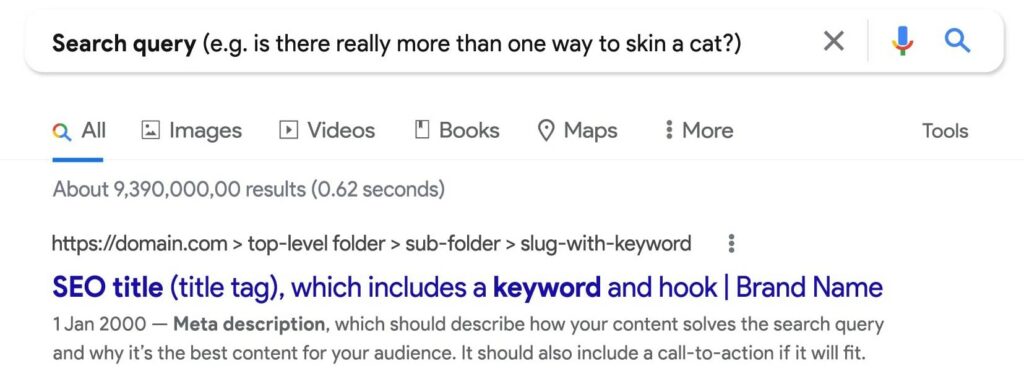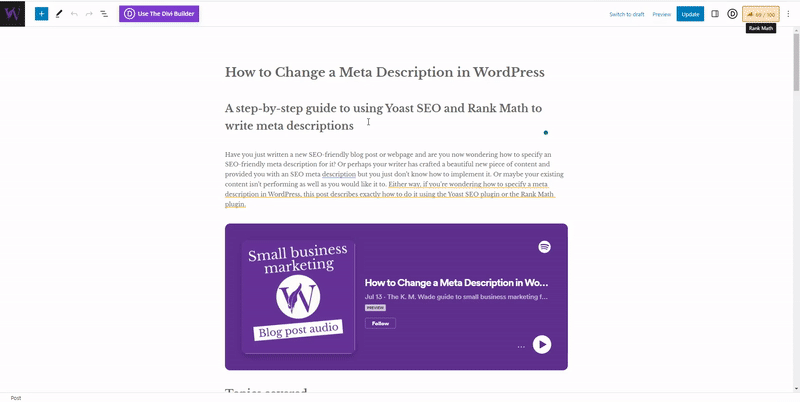A step-by-step guide to using Yoast SEO and Rank Math to write meta descriptions
Have you just written a new SEO-friendly blog post or webpage and are you now wondering how to specify an SEO-friendly meta description for it? Or perhaps your writer has crafted a beautiful new piece of content and provided you with an SEO meta description but you just don’t know how to implement it. Or maybe your existing content isn’t performing as well as you would like it to. Either way, if you’re wondering how to specify a meta description in WordPress, this post describes exactly how to do it using the Yoast SEO plugin or the Rank Math plugin. You can choose between reading the text below or listening to the audio.
Topics covered
Yoast SEO and Rank Math
Ok. First things first. Let’s make sure you’ve got the right plugin.
Rank Math and Yoast SEO are two of many plugins you can use to specify SEO tags like meta descriptions. Both are highly popular. If you haven’t installed one, go and do that now (the free version of each is more than adequate for this task). Here’s a good set of instructions that will guide you through installing and setting up Yoast SEO. Rank Math has a wonderful in-built wizard that will do the same.
While Yoast SEO and Rank Math are both easy to use and effective, I recommend Rank Math as it offers several very useful features in the free version that are only in the paid version of Yoast. The caveat section of this guide includes a very good example of this difference.
What is a meta description? And why do you need a meta description?
I know you probably just want to know how to specify your meta description. But while it’s easy to do, I also know it’s easier to just upload a new webpage or blog post and not bother with the meta description. So, before I teach you how to specify your meta description, I want to make sure you know how important it is so you don’t skip this vital step.
When you google something, you type in a search term or phrase and Google gives you a list of pages (and sometimes other types of content) that it thinks will provide you with the information you’re looking for. Most of the time, you’ll just look at the entries on the first page of these results (the first search engine results page or SERP). If you don’t find what you’re looking for you’ll then look at subsequent SERPs or you might try a different search query.
The entries will look something like that shown in the image below. Each will have a URL, a title, and a brief description. The description is the meta description.

Think about what you do when you google something. If you’re like most web users, when you look at the entries on the SERPs, you probably scan through the headings until you find one that piques your interest. You’ll then read the description to see if the piece of content appears to answer your question or contain the information you’re looking for. If the description indicates the content meets your needs, you’ll click on the entry and take a look at the webpage or blog post (or whatever other type of content the link takes you to). If the description indicates the content is irrelevant you’ll move onto the next interesting heading.
So, the meta description serves two main purposes:
- It convinces the reader it’s worth their time and effort to click through to the piece of content and check it out in more detail.
- It tells Google (and other search engines) what the content is about so it can be displayed to readers when they conduct a relevant search. Importantly, it helps Google determine how close to position 1 in SERPs the content should be displayed.
If you get your meta descriptions right, they can help more people find your content during a Google search and convince those people to consume your content. And more people going to your website means a greater audience for your marketing messages and thus, hopefully, more sales (assuming you’ve got your sales funnels and copy working well).
If you don’t specify a meta description, search engines will have a go at developing their own summaries of your content. Sometimes they do a reasonable job but often they don’t.
If your meta description doesn’t accurately reflect your content and do a good job of convincing readers to consume your content, then you’re going to end up with any or all of the following:
- a low SERP ranking
- a low click-through rate
- a high bounce rate
- low search traffic
- a low sales conversion rate
So, hopefully, you now know how important your meta description is. But you might also now be wondering how to write a good description.
What makes a good meta description?
To be effective, your meta descriptions need to:
- Be between about 120 and 158 characters Well technically, it can be as long as you want but Google will display a maximum of 920px of your meta description so anything longer than that is pretty much wasted. (Bing and Yahoo display up to 980 pixels but given the vast majority of users are using Google, that’s the most important one.) And that works out to be about 158 characters depending on exactly which characters are used. (That’s because the width of English letters and other characters varies so the exact number of characters that fits within 920px varies too.)
To make matters even more complicated, these values are for desktops and laptops. When you view the SERPs on a mobile device, you’re limited to 680px which is about 120 characters. As a result, it’s best to make sure all the most important information is in the first 120 characters.
You can write a meta description that’s less than 120 characters. But you want to fit as much as you can into the space allowed, so if your description is shorter than that, I recommend you have a think about whether there’s anything else you can say about your content.
Yoast SEO will tell you if it thinks your meta description is too long or too short. - Hook the reader. If a search engine user reads your meta description and, based on that, doesn’t think your content will be interesting, useful or relevant to their search, then that user won’t bother clicking through to consume your content. Your goal is to snare the searcher’s attention and make your content appear irresistible.
- Be a good description of your content. If search users click through to your content and find it doesn’t meet their needs, they’ll quickly hit the ‘back’ button and search for another piece of content that floats their boat. If this happens too much, your content’s ranking will start to slide. So, while a hook is important, your meta description still needs to be relevant.
- Contain your primary SEO keyword and at least one secondary keyword. Including your keywords in your meta description helps Google figure out what your content is about. Your reader’s experience is most important but if you’ve chosen good SEO keywords, it shouldn’t be too hard to include your primary keyword and at least one secondary keyword in your meta description in a completely natural way. If you can include one of them near the beginning of your meta description, that’s even better.
If that sounds like too much work, an SEO writer can write your meta descriptions for you.
How to use Yoast SEO to specify a meta description and tell Google and other search engines what description you want them to display in the SERPs
Ok. Now that you’ve got your meta description, how do you tell search engines that you want them to use it? That’s where Yoast SEO comes in. Just follow these simple steps:
- Open your page or blog post.
- Click on the Yoast SEO icon to open the SEO sidebar. OR Scroll to the bottom of your content until you find the SEO section.
- Open the snippet editor and locate the ‘meta description’ field
- Enter your desired meta description. The Yoast plugin will tell you if your description is too long or short. (The red bar in the picture below indicates the text is too long. When the title is a good length, the bar turns green. If your meta description is short enough that Yoast thinks you’re wasting valuable description real estate, the bar will turn orange.) If you’ve been provided with an SEO-friendly meta description by an SEO writer, make sure you use the exact text they’ve specified if you want to get the full benefits of their expertise.
- Save your page (or publish it if you’re ready to publish it). Yoast SEO will then turn your meta description into a meta tag and add it to your page/post’s HTML code.
- And that’s it. Pretty easy right?
How to use Rank Math to specify a meta description and tell Google and other search engines what description you want them to display in the SERPs
The instructions for specifying or editing a meta description using Rank Math are the same for Yoast SEO.
- Open your page or blog post.
- Click on the Rank Math icon to open the SEO sidebar.
- Open the snippet editor and locate the ‘meta description’ field
- Enter your desired meta description. The Rank Math plugin will tell you if your description is too long or short. (The red bar in the picture below indicates the text is too long. When the title is a good length, the bar turns green. If your meta description is short enough that Rank Math thinks you’re wasting valuable description real estate, the bar will turn orange.) If you’ve been provided with an SEO-friendly meta description by an SEO writer, make sure you use the exact text they’ve specified if you want to get the full benefits of their expertise.
- Save your page (or publish it if you’re ready to publish it). Rank Math will then turn your meta description into a meta tag and add it to your page/post’s HTML code.
And that’s it. Pretty easy right?

Additional reading
Your other SEO particulars are also important when you’re trying to improve a piece of content’s position in the SERPs. You can use the Yoast SEO or Rank Math plugin to specify these SEO particulars too. If you need some help, check out these articles:
